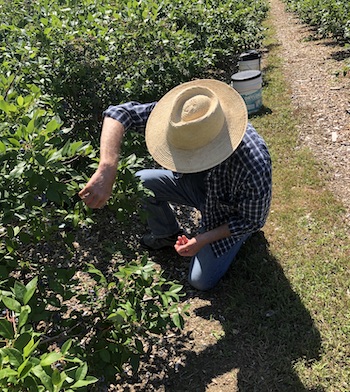When I began writing Chasing the Case three years ago, it was my experiment in writing a mystery, a different genre for me. But as I got into the thick of it, I recognized its potential as a series. Hence, I finished number four, Killing the Story, which has an official release Aug. 26.
The first book was relatively easy because I was introducing amateur P.I. Isabel Long — the protagonist and narrator — and other characters I am carrying throughout the series. They include: Isabel’s 92-year-old mystery-loving mother who is her “Watson;” Jack, who owns the Rooster Bar, where Isabel gets a part-time job; the Old Farts, a group of gossipy old men who hold court in the back room of the general store; plus Isabel’s adult children and regulars at the Rooster. Then there are characters who are one and done such as the father of the woman who disappeared 28 years earlier — Isabel takes this cold case on her own.
So, then I moved onto the second, Redneck’s Revenge, then the third, Checking the Traps, and for now, Killing the Story.
In writing these other books, I was mindful that I wanted to make each to stand on its own in case that it was the first book picked up by a reader. On purpose, I don’t do much rehashing of the previous books although I do include hints and coded references. I develop each character and their description as if this was on the only book I wrote. I don’t want to gyp these readers.
The same goes for those readers who have been following the series. I use those coded references and hints to acknowledge that. I don’t want to beleaguer the past or hit people over the head. I believe that drags a book and readers down. I want these readers to feel like insiders.
So, I address this continuity in the first chapter of Killing the Story. Isabel no longer has the sling she wore throughout case no. 3 after breaking a collarbone in a car crash in no. 2. And per an agreement she made with Gary Beaumont, who hired her in book no. 3, she doesn’t reveal in book no. 4 the results of that case that involved the death of his half-brother. Of course, being nosy New Englanders, especially at the Rooster, she is pestered to spill the beans.
Oh, yes, no. 5 is in the works.
Anyway, here is an excerpt from Killing the Story that will give you an idea of how I handle it. Isabel and Jack attended the funeral for the Police Chief Benjamin Hendricks Sr. in the first chapter.
Many in the church followed the hearse to the cemetery for his burial, and now we’re in the backyard of his family’s home for food, drink, and reminiscing. I’ve heard good stories about the old chief. I offered mine. My mother decided to skip this event. I told her she’d be missing out on a regular who’s who in law enforcement from the hilltowns. But Ma said she felt funny because she had never met the chief and his family in the short time she’s lived with me. I’m here to represent us both.
So, I came with Jack, who’s off getting us beers from the keg in the garage. He found it a good excuse to duck out and not have to listen to another rehashing of my last case with the Beaumont brothers for the True Blue Rooster Regular standing beside me. I don’t blame Jack. People can’t get enough about this case, and frankly, I can’t say much to satisfy the nosy so-and-sos.
“Come on, Isabel. It’s not like you to hold back,” the True Blue, who is a nephew of the old chief, says. He bends closer and lowers his voice to a soft growl. “I promise I won’t tell anybody.”
Yeah, sure. That’s what he said last night, too, when I was tending bar at the Rooster. He even left two bucks for a tip.
“I told you Gary Beaumont wanted me to find out how his brother, Cary, died, and I did. Nobody’s going to jail for it,” I say. “If you wanna find out more, you’re gonna have to ask him yourself. He’s the one who hired me, and we have an agreement.”
The True Blue frowns.
“Like hell I’d do that. That guy’s an asshole.” He inches closer. “I thought you and me were pals.”
Pals? Uh, I don’t think so. I just pour the guy beer when he buys it at the Rooster. I’m friendly when I see him, and I’m not going to risk getting on the wrong side of Gary Beaumont for him.
“Sorry. I wish I could, but I can’t. Hey, here comes Jack with my beer.”
Jack stops to chat briefly with someone, but he picks up his pace across the family’s lawn when I make a sideways wave that this conversation with the True Blue is coming to an end. He gives me a wink. By my estimation, Jack is the best-looking man here, certainly for the over-fifty crowd. But then again, I’m prejudiced. He’s a big hunk of a guy who jokes about his size. He’s got a square jaw and brown eyes. His hair is mostly dark still even though he’s in his sixties, and it’s natural, I know for certain. Mr. Natural. That’s Jack’s style.
He’s also rather new at this togetherness stuff. Before we hooked up, Jack went through a long, long series of dead-end relationships. He’s told me some entertaining stories about the women in town he’s been with, mostly natives. But none ever led to a lasting romance. Well, he came close with one, but that relationship didn’t end well. Remember?
I know Jack cares a lot for me, an awful lot. A couple of weeks ago, I thought for sure he was gonna tell me how much. He was looking for the right moment. It almost happened on an actual date in a fancy restaurant, but we got interrupted by his ex-wife, of all people. Another time, he was about to try again, but then he had to break up a bar fight between two women. Like I said, Jack is new to this kind of relationship. And I can be patient when I put my mind to it.
Ma asked, “Do you think Jack was going to say he loves you?”
I said I didn’t know.
Do I love Jack? I sure like being with him. We have a lot of good laughs and sex. We can talk about most anything. And the man does look out for me. That counts for something. Of course, I’ve just come off a long marriage that produced three kids. Sam and I would still be happy together if he didn’t have that damn heart attack. It was different when I fell for Sam. I was young and giddy. Now, I’m a lot older. I’ve experienced life and death. Do I need someone to tell me he loves me to feel it?
Being with another man after all these years is definitely a new experience, and I don’t want to confuse the joy in that with big love.
Jack hands me a plastic cup.
“This guy bothering you?” he jokes.
“Nah, he’s just being nosy like everybody else in town.”
The True Blue snorts a laugh before he strolls away. I take a sip from my beer. I’m sure it won’t be the final time he or anybody else asks me about my third case, especially since I’m being so close-mouthed. It was that way last night at the Rooster. People were less interested that I was no longer serving beer with my left arm in a sling and more interested in the results of this latest case, which I solved exactly a week before. I got all kinds of offers for the full story. Bigger tips. A venison roast from a guy’s freezer. The choice of a litter of puppies. I will admit the truckload of manure for my garden was awfully tempting.
Even Lisa, the Rooster’s cook, tried to ply me for info by making me a huge salad. She made a noticeable effort to call me Isabel and not Izzie, a name I detest. I will give her credit for originality. But no to Lisa, too.
A promise is a promise even to a bottom-feeder like Gary Beaumont, a bottom-feeder I will admit I’ve come to like.
Not even the Old Farts, those gossipy men stationed in the backroom of the Conwell General Store, got the whole story. I could tell it was driving them nuts on my last visit. The Fattest Old Fart complained the loudest, but then again, he could rightfully be called the Loudest Old Fart.
“See if we share any tips with you again, Isabel,” he said.
“Fat chance that’ll happen,” I responded. “Face it. You guys can’t keep anything to yourselves.”
That comment generated a chorus of snorts and chuckles.
The sling came off Monday after six weeks of being bound up. The doc gave me a clean bill of health although my left collarbone has a permanent jut from where it broke in that car crash. That injury was from two cases ago. I still need to take it easy about heavy lifting on my left side for a while, doctor’s orders. But I have Jack and my two sons to help me with things like that.
Jack leans toward me.
“How much longer you wanna stay?”
“I’d like to say something to the chief’s wife. I didn’t get a chance before,” I say. “Uh-oh, here comes another.”
BOOK: Interested in getting your own copy?
Here’s the link to Kindle and paperback on Amazon: https://mybook.to/KillingtheStory
PHOTO ABOVE: That’s me on a hot summer day after receiving a copy of Killing the Story in the mail from my publisher Darkstroke Books.




